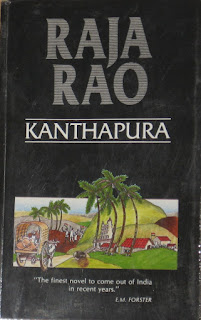Kanthapura
Born Nov.8,1908, Hassan, Mysore,south india-died july 8,( 2006, Austin, Texas,U.S) Indian writer of english-language novels and short stories.
Descended from a distinguished
brahman family in southern India,Rao studied(B.A.,1929)at Nizam
college,Hyderabad,and then left India for france to study literature
and historyat the university of Montpellier andthe sorbonneBorn Nov.8,1908, Hassan, Mysore,south india-died july 8,( 2006, Austin, Texas,U.S) Indian writer of english-language novels and short stories.
- Rao’s second novel:
The Serpent and the
Rope(1960),
Considered
his masterpiece,is a philosophical and somewhat abstact account of a
young intellectual Brahman and his wife seeking spiritual truth in
India, France, and England;it plays on the dialogue between Orient
and Occident. His four books
up to date are the novels.
- Kanthapura -1938
- The Serpent and the Rope -1960
- The Cat and Shakspeare-1965
- The Cow of the Barricades-1947
- Kanthapura-The Village:
‘knathapura’
portrays the participation of a small village of south India in the
national struggle called for by Mahatma Gandhi. Imbued with
nationalism,the villegers sacrifice all their material possessions in
a triumph of the spirit, showing how in the Gandhian movement people
shed their narrow prejudices and united in the common cause of the
non-violent civil resistance to the British Raj.
Class
structure:
- Untouchability
- Structure of the village
- Superstitions among people
- Exploitation due to class
- Caste and creed
- Class discrimination
- Society and discrimination
We see some points about it:
- Untouchability :
Kanthapura has narrow structure.
In this village have people of many castes. They lived peacefully. In
this village upper class people otherwise they were casted out from
that particular.if a person goes to Pariah’s house, he would to
take bath and go Kashi for Purification purpose.
- Structure of the village:
In the village house were the
symbols of status. There wereless government serrvents in this
village. Those who were there got respect. There was the house of
post master. He lived in two stories building. Palwari had glass
paned windows. The houses are individualized and particularized.
- Exploitation due to class:
The
condition of the village was such that upper class-exploited the
lower class people.the whole description of working labourers is
touching. Remaining hungry of half hungry,poorly-nourished they had
to work very hard.
- Caste and creed:
The
small village symbolically, depicts the country’s condition, during
the time of freedom struggle,people of all castes unanimously united
themselves to fight against the country’s enemy. Educated people
were influenced by Gandhi and became his followers. They cast away
the social norms of caste.
- Conclusion:
Raja Rao’s Kanthapura is one
of the finest novel to come out of mid-twntieth century India. It is
the story of how Gandhi’s struggle for independence from the
British came to a typical village, Kanthapura in South India. Younge
Moorthy, back from the city with”New Ideas”cuts across the
ancients barriers of caste to unite the villages in non-violent
action which is met with violence by landlords and police.


No comments:
Post a Comment